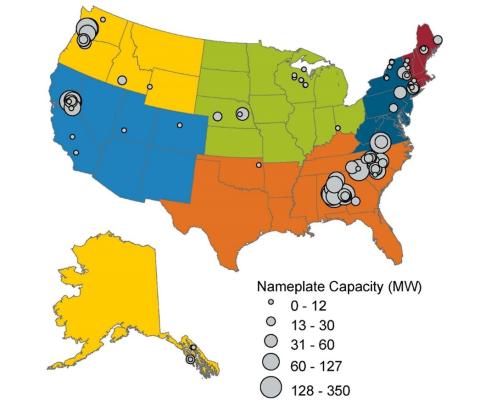
Dataset Overview
Environmental flow requirements included in Federal Energy Regulatory Commission (FERC) hydropower licenses are important for balancing natural properties and benefits of river ecosystems (e.g., healthy species, recreation, water supply, flood control) supporting hydropower production. In some cases, environmental flow requirements may limit operational flexibility given current operational schemes and make a hydropower plant less able to provide power to the electric grid on demand. Hydropower plants may gain some flexibility as hydropower scheduling time periods are made to be more responsive to the short-term needs of an energy grid increasingly reliant on intermittent renewables. However, many flow requirements focus on the daily, monthly, or seasonal flow fluctuations which matches the time scale of most paradigms linking flow alterations to the health of river ecosystems. This dataset seeks to provide a greater understanding of how flexibility in environmental requirements can be leveraged to create positive outcomes for both the power system and the environment.
It contains information on environmental flow requirements from the Protection, Mitigation, and Enhancement section of 50 randomly selected FERC licenses: 25 issued from 1998-2013 that were also included in the ORNL Mitigation Database (Schramm et al. 2015) and 25 issued from 2014-present.
The information on environmental flow requirements was extracted from the PM&E section of 50 randomly selected FERC licenses: 25 issued from 1998-2013 that were also included in the ORNL Mitigation Database (Schramm et al. 2015) and 25 issued from 2014-present. The flow requirements were then categorized into flow augmentation categories based on whether the license stated a specific water management purpose for the given requirement called augmentation categories (i.e., fisheries or habitat, recreation or boating, industry, and general or unspecified; Table B). Requirements were also grouped into flow type categories (e.g., minimum flow rate, maximum flow rate, ramping rate). Additional information related to flow requirements such as the augmentation time-period and whether the flow rate was continuous (i.e., condition must be present at all-times) or instantaneous (i.e., condition present at a point in time) was also extracted from the licenses. Some licenses had specific flow requirements based on whether the project was in a wet, dry, or normal water year. If that information was presented in the license, it was also included in the data set. The location within the project was noted, hereafter, zone, in the dataset for flow requirements relating to specific areas of hydropower projects (Dam, Powerhouse, Bypass Reach). Maximum discharge capacities of hydropower facilities were also extracted from both the Existing Hydropower Assets (EHA) data set and the National Inventory of Dams (NID) databases. Each facility was coded with project identification codes from the EHA dataset to facilitate cross-referencing between datasets.